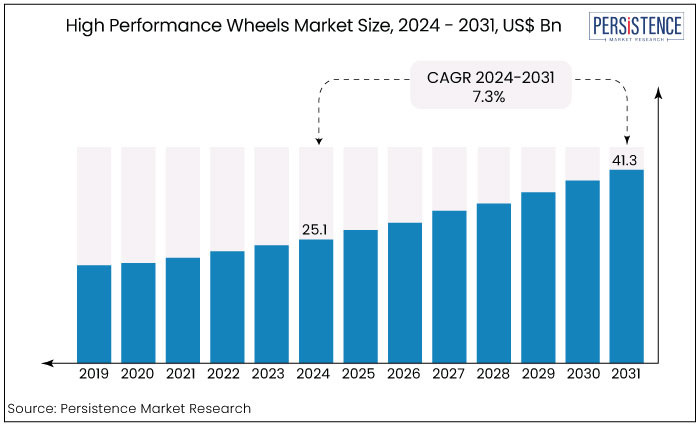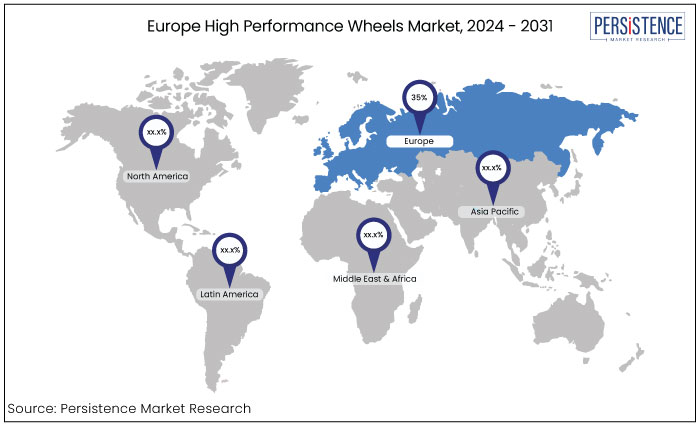Industry: Automotive & Transportation
Published Date: October-2024
Format: PPT*, PDF, EXCEL
Delivery Timelines: Contact Sales
Number of Pages: 182
Report ID: PMRREP34857
The high performance wheels market is estimated to increase from US$25.1 Bn in 2024 to US$41.3 Bn by 2031. The market is projected to record a CAGR of 7.3% during the forecast period from 2024 to 2031. The market is driven by growing demand for lightweight, durable wheels in luxury, sports, and electric vehicles, with advancements in sustainable materials and 3D printing boosting innovation.

Key Highlights of the Market
|
Market Attributes |
Key Insights |
|
High Performance Wheels Market Size (2024E) |
US$25.1 Bn |
|
Projected Market Value (2031F) |
US$41.3 Bn |
|
Global Market Growth Rate (CAGR 2024 to 2031) |
7.3% |
|
Historical Market Growth Rate (CAGR 2019 to 2023) |
4% |
|
Region |
Market Share in 2024 |
|
Europe |
35% |
The existence of significant companies in Europe, the early adoption of innovative technology, and the increasing customer preference for luxury automobiles are anticipated to enhance growth in the region. The competitive luxury automobile sector and governmental pollution regulations are poised to facilitate expansion in Europe. For instance, the European Commission announced the implementation of Regulation (EC) 443/2009, effective January 1, 2020, to mitigate vehicular emissions.
Asia Pacific occupies the second largest market position. The escalating sales and production in the region together with the growing disposable incomes of consumers are the primary factors driving its rapid rise. North America is anticipated to exhibit substantial market expansion because of rigorous safety and emission regulations. Prominent entities in the region are concentrating on the production of lightweight wheels to improve vehicle fuel efficiency.

|
Category |
Market Share in 2024 |
|
Material Type - Aluminum |
60% |
The market is divided into aluminum, steel, magnesium, and carbon fibre based on material. Among these, the aluminium material dominates the market. The aluminum sector is anticipated to lead the market throughout the forecast period. Aluminum wheels exhibit superior durability and strength compared to magnesium wheels. They are also economical and have simple designs than magnesium and carbon fiber wheels.
Aluminum wheels exhibit excellent thermal conductivity and ensure accurate braking. They are gaining popularity due to their attractive design and lightweight characteristics. The magnesium sector is expected to occupy the second-largest share of the market. Magnesium wheels are predominantly utilized in racing due to their superior strength-to-weight ratio compared to alternative wheels.
|
Category |
Market Share in 2024 |
|
Sales Channel - Aftermarket |
62% |
The market is divided into OEM and aftermarket based on sales channel. Among these, the aftermarket sales channel dominates the market. The rising demand for magnesium and aluminum wheels due to their disordered aftermarket pricing of innovative components worldwide is poised to bolster the supremacy of the aftermarket business.
Aftermarket components may adhere to or deviate from the safety regulations established by governments. It may diminish the revenue of the organized aftermarket but can enhance the revenue of the automobile aftermarket for high-performance wheels.
The disorganized, important aftermarket participants offer premium wheels at a far lower price, plus customization tailored to customer specifications. The OEM category is anticipated to exhibit substantial expansion in the market. It is poised to maintain the second position, fueled by the increasing emphasis of major OEMs on developing sophisticated wheels at a competitive price.
High-performance wheels exhibit little likelihood of galvanic corrosion, are lightweight and compact, and provide superior braking compared to alternative wheels. The wheels can diminish unsprung mass, thereby alleviating the unpleasant vibrations of cars. The vehicle's substantial weight leads to diminished fuel efficiency and increased emissions.
Conventional cars constitute the predominant source of air pollution worldwide. Governments in multiple nations have enacted rigorous emission standards to mitigate escalating air pollution. The government of India enforced BS-VI regulations in April 2020. This is anticipated to mitigate the nation's escalating air pollution.
The rising sales of luxury vehicles in countries such as the U.K., Germany, and the U.S., these wheels augment the vehicle's aesthetic appeal. It is driven by consumer preference for safe and fuel-efficient options is anticipated to stimulate demand for high-end automobiles during the projected period.
The high performance wheels market has witnessed significant growth before 2023, driven by increasing demand for luxury and sports vehicles as well as advancements in materials such as carbon fiber and aluminum alloys. Such materials provide enhanced strength and light weight, which are critical for performance vehicles.
The growing popularity of electric vehicles (EVs) and SUVs has also contributed to the demand for high-performance wheels as manufacturers seek to improve overall vehicle efficiency and aesthetics. Before 2023, the market benefitted from rising disposable incomes and an increase in motorsports and car customization activities globally.
The market is expected to continue its upward trajectory post-2024 primarily fueled by the increasing adoption of electric and hybrid vehicles. These vehicles require light, strong wheels to maximize performance and battery efficiency. A growing focus on sustainability and eco-friendly materials is encouraging the development of new materials and manufacturing processes.
Advancements in 3D printing and smart wheel technologies are likely to provide new growth opportunities, while stringent government regulations on carbon emissions will push manufacturers to innovate. The market is projected to experience a steady CAGR supported by the ongoing trends in vehicle electrification and the demand for high-end automotive performance enhancements.
Increasing Demand for Lightweight and Durable Materials
The ongoing demand for light and strong materials in the automotive industry is a significant driver for high-performance wheels. Aluminum alloys, carbon fiber, and magnesium have become popular materials due to their weight-reduction properties without compromising strength.
Light wheels improve fuel efficiency, acceleration, and overall vehicle performance particularly for high-performance and electric vehicles. As fuel economy standards become strict and the push for sustainable materials grows, the adoption of lightweight wheels is expected to increase. High-performance wheels made from such materials also enhance handling and braking, making them essential for sports cars and luxury vehicles.
Growth of Electric and Hybrid Vehicles
The rapid expansion of electric and hybrid vehicles (EVs) is a key driver for the high performance wheels market. EVs require light and more aerodynamic wheels to optimize energy efficiency and range, making high-performance wheels crucial for EV manufactures.
The increased torque EVs generate also necessitates strong wheels to handle the enhanced performance demands. As governments worldwide promote green vehicles and the EV market expands, there will be a corresponding rise in demand for wheels designed specifically for EVs, further driving market growth post-2024.
High Manufacturing Costs
One of the key challenges facing the high performance wheels market is the high manufacturing cost. While highly effective for enhancing performance, materials like carbon fiber and magnesium alloys are significantly expensive to produce than traditional steel or aluminum.
The complex manufacturing processes involved including precision engineering and finishing, drive up production costs, which are then passed on to consumers. As a result, high-performance wheels still need to be within reach for many mass-market vehicle buyers limiting their adoption primarily to luxury vehicles and premium segments. This price barrier slows market penetration in broad automotive categories especially in price sensitive regions.
Limited Awareness and Availability in Emerging Markets
In emerging markets, where the automotive industry is still developing, the demand for high-performance wheels is restricted due to limited consumer awareness and availability. Many consumers in these regions prioritize affordability and basic functionality over performance enhancements making it difficult for high-performance wheel manufacturers to tap into these markets.
The lack of widespread distribution networks and expertise in these areas further hampers market growth. High import duties and tariffs in certain countries can also make these wheels even less accessible to broad audience.
Integration of Advanced Manufacturing Technologies
One prominent trend in the high performance wheels market is the increasing adoption of advanced manufacturing technologies such as 3D printing and automation. These technologies are revolutionizing the production process by enabling manufacturers to create light, strong, and complex wheel designs efficiently.
3D printing allows for highly customized designs that were previously difficult to achieve with traditional methods opening up opportunities for innovation in both performance and aesthetics. The technology is also being used to reduce material waste improving sustainability while maintaining the integrity and quality of high-performance wheels.
Automation in production lines enhances precision and reduces the time it takes to manufacture wheels. This helps manufacturers keep up with the rising demand for high-performance wheels in various segments such as luxury, sports, and electric vehicles. Automated systems can precisely control the application of coatings and finishes, ensuring consistent product quality while cutting labour costs.
As consumer demand for personalization and high-quality performance wheels grows, these technologies will become more widespread, allowing manufacturers to scale their production while maintaining cost-effectiveness. This trend reflects the growing need for innovation to balance performance, efficiency, and sustainability in automotive design.
The high performance wheels market is characterized by the presence of several prominent global players, each focusing on innovation and advanced technologies to maintain a competitive edge.
Key players in the market include BBS GmbH, OZ S.p.A., Ronal Group, and HRE Performance Wheels, all of which specialize in lightweight and durable materials such as aluminum, magnesium, and carbon fiber. Such companies are investing heavily in research and development to create wheels that meet the evolving demands of high-performance vehicles and electric vehicles (EVs).
The market is highly competitive with manufacturers striving to offer customized solutions that enhance vehicle performance, aesthetics, and fuel efficiency. Partnerships with luxury and sports car manufacturers along with advancements in 3D printing and smart wheel technologies are further intensifying the competition.
Recent Industry Developments in the High Performance Wheels Market
|
Attributes |
Details |
|
Forecast Period |
2024 to 2031 |
|
Historical Data Available for |
2019 to 2023 |
|
Market Analysis |
US$ Billion for Value |
|
Key Regions Covered |
|
|
Key Market Segments Covered |
|
|
Key Companies Profiled in the Report |
|
|
Report Coverage |
|
|
Customization & Pricing |
Available upon request |
By Material
By Sales Channel
By Vehicle Type
By Region
To know more about delivery timeline for this report Contact Sales

The market is estimated to be valued at US$41.3 Bn by 2031
The market is projected to exhibit a CAGR of 7.3% over the forecast period.
Some of the leading industry players in the market are MAXION Wheels, Steel Strips Wheels Ltd, and ESE Carbon.
Europe stands out as the leading regional market.
Aftermarket sales channel accounts for significant market share.